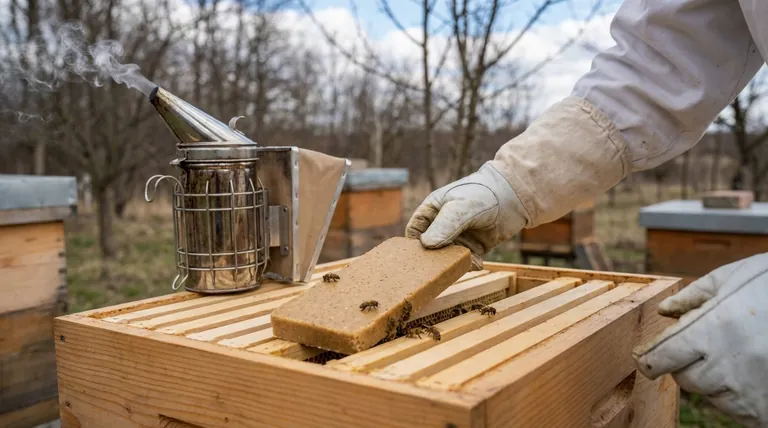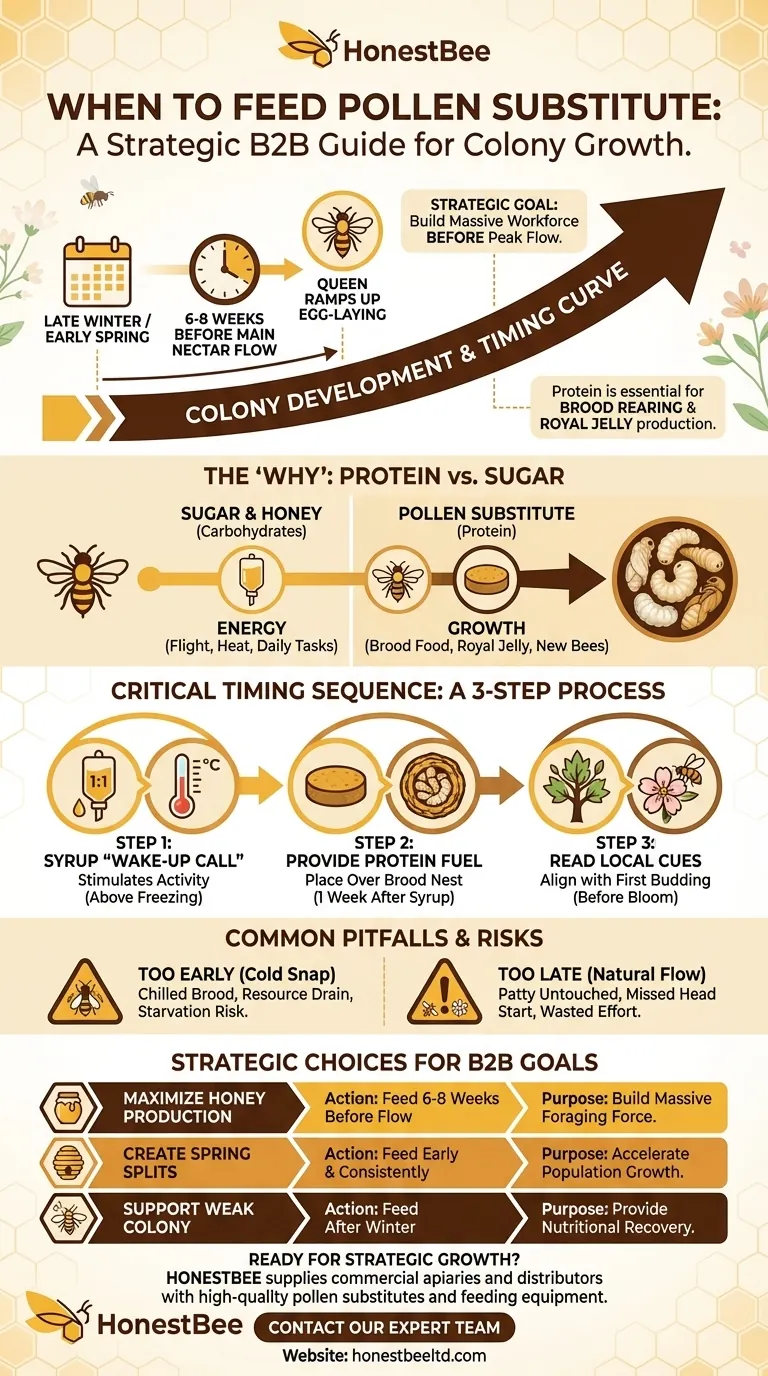In short, the best time to feed pollen substitute is in late winter or early spring, about 6 to 8 weeks before the main nectar flow begins in your area. This feeding should start shortly after you provide a light, stimulatory syrup feed. The goal is to provide the protein necessary for a population boom precisely when the queen is ready to ramp up her egg-laying, ensuring a massive workforce is ready for the first major bloom.
Pollen substitute is not just food; it is a strategic tool for population management. Its purpose is to stimulate brood rearing before natural resources are abundant, aligning your colony's peak strength with the peak nectar flow. Mistiming this intervention can lead to starvation or a missed opportunity.

The "Why" Behind the "When": Protein's Role in Colony Growth
To use pollen substitute effectively, you must understand its role in the colony's biology. It's not just about providing food; it's about providing the right kind of resource at the right time.
Sugar vs. Protein: Fuel for a Growing Family
Honey and sugar syrup are carbohydrates. They provide the energy for adult bees to fly, generate heat, and perform daily tasks.
Pollen, or pollen substitute, is protein. Protein is essential for growth. Nurse bees consume it to produce brood food (royal jelly) to feed to larvae, and the queen requires it to produce eggs. Without protein, the colony cannot raise new bees.
Stimulating the Queen to Lay
As winter ends, the colony's goal is to transition from a small survival cluster into a booming workforce. A light 1:1 sugar syrup feed signals to the bees that a nectar flow has begun.
This signal encourages the queen to start laying more eggs. However, she cannot sustain a high rate of egg-laying, and the workers cannot feed the resulting larvae, without a corresponding protein source. This is where pollen substitute bridges the gap.
Building the Future Foraging Workforce
A bee's life cycle from egg to foraging adult takes about six weeks. By feeding pollen substitute in early spring, you are investing in the generation of bees that will be at their peak foraging age when your local honey flow begins.
This proactive buildup is the key to maximizing your honey harvest. You are creating the workforce before the work becomes available.
Understanding the Critical Timing Sequence
The effectiveness of pollen substitute is entirely dependent on proper timing and sequence. It’s a process, not a single event.
Step 1: The Syrup "Wake-Up Call"
Begin by feeding a light 1:1 sugar syrup (by weight) once temperatures are consistently above freezing and the bees can take short cleansing flights. This mimics an early spring nectar flow and stimulates the colony's activity.
Step 2: Providing the Protein Fuel
About a week after starting the syrup, place the pollen substitute patty directly on top of the brood nest frames. The bees need easy access to it in the warmth of the cluster. They will begin consuming it to feed the expanding brood nest initiated by the queen.
Step 3: Reading Your Local Environment
The calendar is only a rough guide. "Early spring" varies dramatically by location. The ideal time to start this process is when the first pollen-bearing trees in your area, like maples and willows, begin to bud but have not yet bloomed.
Common Pitfalls to Avoid
Timing is a balancing act. Getting it wrong can do more harm than good, making it crucial to understand the risks.
The Danger of Feeding Too Early
If you feed pollen substitute when it's still too cold, you encourage the queen to lay a large patch of brood. If a cold snap returns, the winter cluster may not be large enough to keep this expanded brood nest warm.
This results in chilled brood, which dies and must be removed by the bees, wasting precious energy and resources. The larger, active population will also consume winter stores much faster, risking starvation before natural forage is available.
The Missed Opportunity of Feeding Too Late
If you wait until natural pollen is abundant, your pollen substitute will likely go untouched. The bees will always prefer the real thing.
While this doesn't harm the colony, it is a waste of your money and effort. More importantly, you will have missed the window to get a head start on brood rearing, and the colony's buildup will be slower.
When Not to Feed
Do not feed pollen substitute during a strong natural pollen flow or during late summer. Fall feeding can sometimes stimulate a late-season brood cycle, creating young bees that may not be properly prepared for winter.
Making the Right Choice for Your Goal
Apply this knowledge based on your specific beekeeping objectives.
- If your primary focus is maximizing honey production: Begin your syrup and pollen feeding sequence 6-8 weeks before your region's main nectar flow to build the largest possible foraging force.
- If your primary focus is making spring splits: Feed early and consistently to accelerate population growth, allowing you to create strong new colonies as soon as the weather is stable.
- If your primary focus is helping a weak colony: Use pollen substitute to provide critical nutritional support after winter, helping a smaller population recover and build strength for the season.
Ultimately, using pollen substitute is about proactively managing your colony's growth curve to meet the opportunities of the season ahead.
Summary Table:
| Timing Goal | Key Action | Purpose |
|---|---|---|
| Maximize Honey Production | Feed 6-8 weeks before main nectar flow | Build a massive foraging force for the honey flow. |
| Create Spring Splits | Feed early and consistently | Accelerate population growth for strong new colonies. |
| Support a Weak Colony | Feed after winter | Provide nutritional support for population recovery. |
Ready to build stronger, more productive colonies?
Strategic feeding is key to successful beekeeping. At HONESTBEE, we supply commercial apiaries and beekeeping equipment distributors with the high-quality supplies needed to manage colony growth effectively.
We can help you get the right pollen substitutes and feeding equipment to perfectly time your interventions for maximum honey yields and colony health.
Contact our expert team today to discuss your beekeeping needs and explore our wholesale-focused product lines.
Visual Guide

Related Products
- Economy Galvanized Beekeeping Honey Bee Smoker for Wholesale
- Professional Bee Smoker with Elongated Spout and Durable Bellows for Beekeeping
- High Performance Plastic Queen Excluder for Beekeeping and Apiary Management
- Wooden Queen Bee Excluder for Beekeeping
- Professional Galvanized Hive Strap with Secure Locking Buckle for Beekeeping
People Also Ask
- What is the purpose of a bee smoker in beekeeping? Ensure Calm, Safe Hive Inspections
- What type of smoke is needed to calm honey bees? Use Cool, White Smoke for a Safe Hive Inspection
- What are some alternatives to using smoke in beekeeping? A Guide to Gentle Hive Management
- How did early beekeepers use bee smokers? Master Ancient Bee Calming Techniques
- What are the common design features of a bee smoker? Choose the Right Smoker for Your Apiary



















